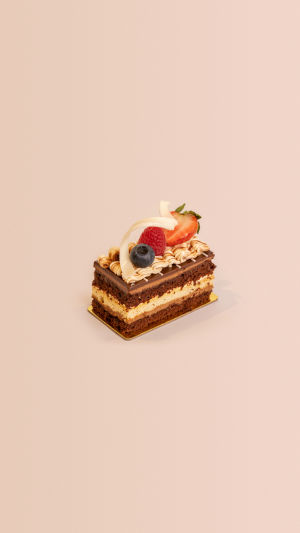Making cake at home is a true joy for many dessert lovers. The act of baking a delicious cake that turns out just right can bring happiness for the whole day. But even if we follow a recipe, sometimes the cake still doesn't come out as expected.
That's why in this article, we'll give you a complete guide to making the perfect chiffon cake and share 4 essential tips to help you master cake-making at home, so you can enjoy a delightful homemade cake with ease.
<h3>How to Make Cake: Chiffon Cake Recipe and Preparation</h3>
Different types of cakes require different ingredients and methods. In this guide, we'll focus on the classic chiffon cake, showing you exactly how to prepare the ingredients and the steps to make it. We want you to be able to bake a delicious cake in your own kitchen with ease!
<h3>Ingredients for Chiffon Cake</h3>
Chiffon cakes are made with two main parts: egg yolk batter and egg white meringue.
<b>Egg Yolk Batter Ingredients:</b>
• 3 egg yolks
• 15g sugar
• 35g vegetable oil
• 60g milk
• 80g cake flour
<b>Egg White Meringue Ingredients:</b>
• 3 egg whites
• 45g sugar
• 1/4 tsp lemon juice
<h3>Steps to Make Chiffon Cake</h3>
1. Start by mixing the egg yolks with 15g of sugar. Whisk them together thoroughly until the sugar has completely dissolved.
2. Add the vegetable oil to the mixture, continuing to whisk until the egg yolks and oil are fully blended.
3. Pour in the 60g of milk, mixing well.
4. Sift the cake flour and add it to the mixture, stirring gently until the flour is fully incorporated and there are no lumps.
5. Now that the egg yolk batter is ready, set it aside.
6. For the egg white meringue, whisk the egg whites until they form coarse bubbles. Add the lemon juice and gradually add the sugar in three parts, continuing to whisk until the meringue forms stiff peaks.
7. Preheat your oven to 160°C (320°F) and let it warm up for about 10 minutes.
8. Gradually fold one-third of the egg white meringue into the egg yolk batter, stirring quickly but gently. Be careful not to over-mix, as this could deflate the batter.
9. Repeat this step with the next third of the meringue, then fold the final third in, ensuring everything is evenly mixed.
10. Pour the cake batter into your cake pan, tap the pan lightly to release any large air bubbles, and pop any remaining ones with a skewer.
11. Bake at 140°C (284°F) for 30 minutes. Afterward, test the cake by inserting a skewer. If it comes out clean, the cake is ready.
12. Once the cake is out of the oven, give the pan a slight shake, then invert the cake pan and allow it to cool completely before removing the cake from the pan.
<h3>Why Do Cakes Fail? Understand These 4 Tips to Make a Perfect Cake</h3>
Even when we follow the recipe exactly, sometimes the cake doesn't turn out as we hoped. If this happens to you, let's go over some common reasons cakes fail and four essential tips to ensure you get it right every time.
<h3>1. Ingredient Temperature Matters</h3>
Never underestimate the importance of ingredient temperature. The temperature of eggs and butter plays a big role in whether the cake will succeed. For recipes like chiffon or rolled cakes, it's better to use chilled eggs. On the other hand, sponge cakes made with whole eggs do better with room-temperature eggs.
<h3>2. Accurate Ingredient Measurements</h3>
If the proportions or quantities of ingredients are off, your cake is likely to fail. Make sure to measure everything precisely. If you're adjusting the recipe size, we recommend using a recipe converter tool or app to avoid errors from manual calculations.
<h3>3. Stir Quickly to Prevent Deflation</h3>
Mixing is a key part of cake-making. While it's essential to incorporate all the ingredients, the time you spend mixing is just as important. Over-mixing can cause the batter to lose air and result in a dense cake. Always use the right tools, such as an electric mixer, to help you mix efficiently without over-stirring.
<h3>4. Oven Temperature Matters</h3>
The temperature of your oven can make or break your cake. Too high, and the cake could burn. Too low, and it might come out too dry or too dense. Always preheat your oven and keep an eye on the temperature for the best results.
<h3>The Best Tool to Help You Make Cake: The Bamix Food Processor</h3>
After learning the steps and tips to perfect your cake-making, we hope you feel more confident in making your own cakes at home! If you don't have the right equipment, consider getting the Bamix food processor. Not only can it help with mixing and whipping, but it also features interchangeable attachments, replacing 14 different kitchen gadgets (like mixers, blenders, and frothers). It's the best kitchen assistant for all your baking needs.
With the right ingredients, tools, and techniques, we can all make perfect cakes at home. Whether you're a seasoned baker or a beginner, follow these tips to avoid common mistakes and bake a fluffy, moist cake every time. So, what are you waiting for, Lykkers? Get your apron on and start baking!





